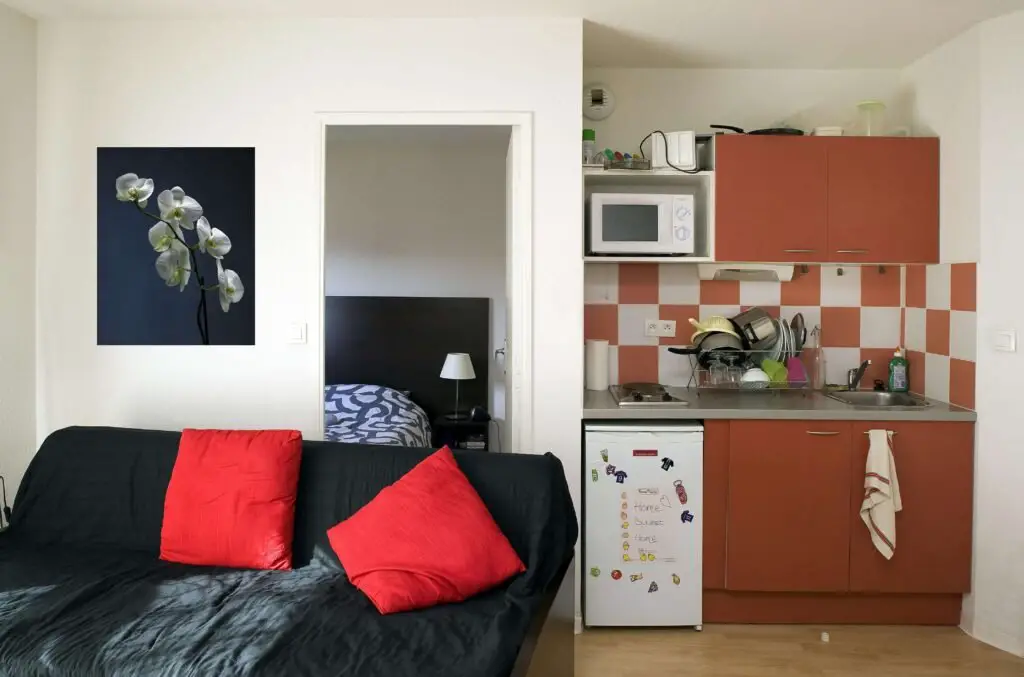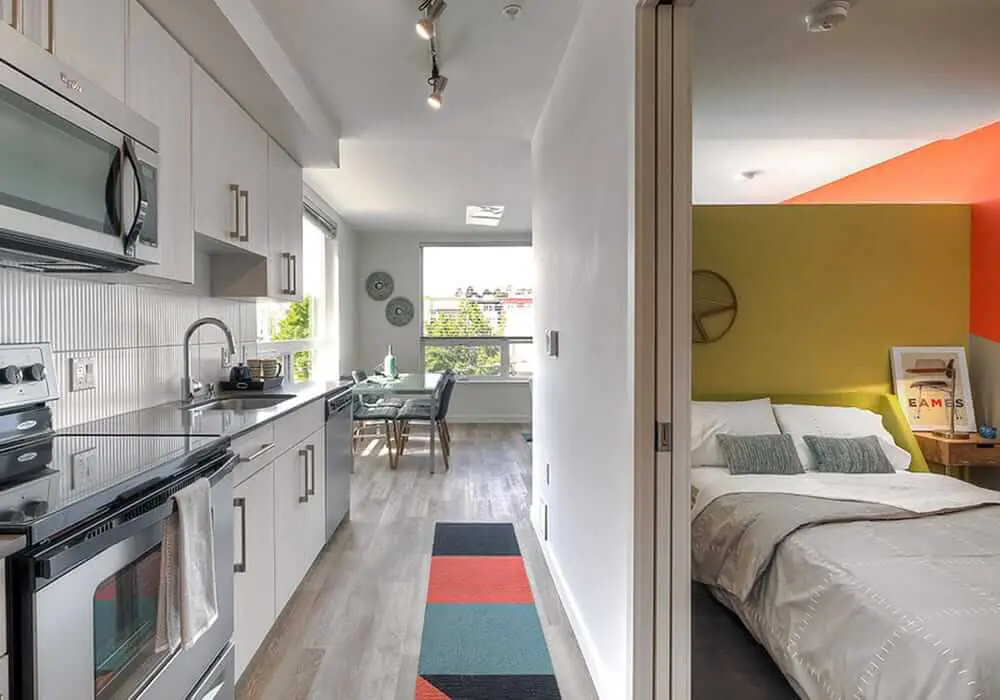Last Updated on July 27, 2023 By Emma W. Thomas
A Jr. one-bedroom apartment is smaller than a standard one-bedroom apartment and typically lacks a separate bedroom. Instead, it has a smaller alcove or partitioned area for sleeping, while the rest of the space serves as a combined living and kitchen area. A one-bedroom apartment has a fully enclosed bedroom separate from the living area.
Comparison of A Jr. One Bedroom And A One-Bedroom
| Jr. One Bedroom | One-Bedroom Apartment |
|---|---|
| Smaller size | Larger size |
| Usually lacks a separate bedroom | Has a fully enclosed bedroom |
| May have an alcove for sleeping | Distinct and private bedroom |
| Combined living and kitchen area | Separate living and kitchen area |
| Lower rent in most cases | Potentially higher rent |
| Ideal for single occupants or couples | Suitable for individuals, couples, or small families |
| Limited privacy | Enhanced privacy and separation |
| Fewer storage options | More potential storage space |
| Less square footage | More square footage |
What Are The Differences Between A Jr. One-Bedroom Apartment And A One-Bedroom Apartment?

Other than the general layout of the Jr. one-bedroom and a one-bedroom apartment, there are other differences. They include;
Cost
It is always cheaper to rent a Jr. one-bedroom than a one-bedroom apartment. In most cases, it is because of the available space in both housing types. A Jr. one-bedroom apartment usually costs several hundred dollars cheaper than a one-bedroom, which depends on the square footage and luxury. A one-bedroom apartment attracts higher prices because of its size and other distinguishing features. A Jr. one-bedroom is the best choice for most young professionals and students who wish to save some cash used to cover the grocery or other utility bills.
Occupancy
One-bedroom apartments are better, especially if you are moving in with a roommate or a partner. After all, they offer more space, comfort, storage, and privacy for cohabiting people than a Jr. one-bedroom. Even though the Jr. one-bedroom is not as small as studio and efficiency apartments, they tend to have a crowding feeling whenever more than one person lives in such a space. If you plan to live with another person in a Jr. bedroom, you will have to downsize your belongings to ensure enough space for storage and living.
Lifestyle
You can decide on what apartment size to live in, depending on your lifestyle. A one-bedroom apartment is better than a Jr. one-bedroom for a person who is into hosting people. A one-bedroom apartment will provide more space for the guests to relax and get comfortable. It will also promote privacy such that there will be minimal interaction with some of your private items.
The additional space from the one-bedroom apartment will also allow you more storage space to add more furnishings and other home décor accessories, which would not be the case for a Jr. one-bedroom. You always strain to save on space, and if you host guests in your place, they will always be surrounded by your items, leaving them with no room to spread out.
Remote Work
During the Covid-19 pandemic, most people were forced to work from home. It is not impossible to work from a Jr. one-bedroom apartment, but it is uncomfortable to eat, work, sleep, and relax in the same room throughout the day. Sometimes, Jr. one-bedroom apartments do not provide the flexibility needed for a work-life balance. On the other hand, a one-bedroom apartment can serve you perfectly well, even to save your sanity. It provides you with flex space from any house position you decide, such as in the hallway or in the living room corner, where you can set up your home office.
Location
Jr.one bedroom is easier to find in urban and trendy areas at a lower price, unlike one-bedroom apartments that tend to be expensive and usually located a little further from towns and cities. Most of them are like a 20 minutes drive away from the cities, leaving you with the chance to decide whether to sacrifice all the trendy bars, restaurants, and cultural events in the city for a bedroom and some additional space.
What Are The Other Types Of Apartments?
Apartments come in different sizes and layouts. Understanding the types of apartments can help you decide faster on what suits your needs best. Below are the most common types of apartments and their distinctive differences;
Studio Apartments
Studio apartments consist of one large room serving as an open living space. They include the living space, sleeping area, and kitchen space all in one area. The only room that has a separating door is the bathroom leaving you with very little privacy. Most studio apartments are between 300-600 square feet in size.
Alcove Studio Apartments
These are similar to the studio apartments, with the only difference being a separate nook(alcove). The alcove serves as a separating nook leaving the apartment with a space that can serve as a sleeping area. Since the nook creates some separation, it has more privacy than the studio apartment, an all-open space.
Convertible Apartment
It is also commonly known as a Jr. one-bedroom apartment since it has some extra space that creates a bedroom or a separate space. It requires you to use a semi-permanent wall or curtains to divide the rooms, enhancing your privacy.
Micro Apartments
They are typically less than 300 square feet in size and usually come with a fully functional kitchen. Even though they are smaller than other apartment types, they have high ceilings and flexible living spaces, which helps to create more open areas when needed. For example, some come with foldable bed that can fold up into the wall during the day, leaving up more living space.
One-Bedroom Apartment
According to the American Society of home inspectors, one-bedroom apartments contain a true bedroom which must be 70-80 square feet. It should also have a functional air conditioning system, an openable window and door, and a ceiling of at least a height of seven feet.
Aloft
Lofts are typically large rooms with high ceilings, large windows, and few walls. They are similar to the studio apartments as they have full open kitchens and sleeping areas, with their only difference being their sizes. Lofts are much larger and are built in old warehouses and factories that have been converted into residential spaces.
What Is A junior One-Bedroom?
It is easy to confuse a junior one-bedroom apartment with a studio or alcove apartment. They may be similar, but the Jr. one-bedroom apartment has an extra room. Ideally, a standard Jr. bedroom should have a room large enough to fit your bed and other small furniture pieces like a nightstand or a small dresser. Things such as the sleeping area vary from state to state such that you might find the extra sleeping area doorless.
If you find your junior one-bedroom apartment has no door, you can use a curtain to cover up the entrance. A curtain is a cheap and easy way to enhance privacy without feeling claustrophobic. You can also go for a foldable screen door with a wide range of choices depending on the material, price, size of your doorway, and most importantly, your needs.
Some people tend to use the extra sleeping space in other ways instead of having it as their bedroom. For instance, people who work from home can use it as their home office. Space is usually well-secluded such that there is minimal distraction making it suitable for use as a home office or a study room. Since the room is not an actual bedroom, it lacks outlets such as cable extensions, and therefore, for it to function as a home office, you will have to run some codes to charge any electronics you might be using.
What Are The Pros And Cons Of A Junior One-Bedroom Apartment?

Some of the pros and cons associated with a junior one-bedroom apartment include;
Pros
Privacy
Even though the room’s layout is not fully separated like in the one-bedroom apartments, they tend to have some levels of privacy which is not available in the studio apartment. Since you can use a curtain or a foldable screen door, it can help with privacy issues, especially when you have guests, reducing their interaction with your personal effects.
Easy Cleaning
Their small size with less square footage leaves you with a small cleaning area. If you have only a few belongings, your Jr. one bedroom shouldn’t take up much of your time to clean with proper organization.
Cheaper Than A One-Bedroom Apartment
Some people, such as college students or young professionals, will prefer a Jr. one-bedroom apartment which tends to be cheaper than a one-bedroom apartment since they come with almost similar features. College students do not need a lot of space since they have less furniture enough to fit in a Jr. one-bedroom; hence no need for too much extra space.
Cons
Too Small
Sometimes they tend to be too small since all the rooms are perked in one living space, making it unsuitable for a person with extra furniture pieces. In most cases, the sleeping area can only accommodate a bed and nothing else.
They Are More Expensive Than Studio And Alcove Apartments
It is not logical to pay extra cash just because the room is separated, yet it has no door. Most junior one-bedroom apartments are the same size as standard studio apartments.
Conclusion
Deciding on whether to go for a Jr. one-bedroom apartment or a one-bedroom apartment highly depends on the kind of lifestyle you live. If you love a lot of privacy and hosting guests, you should go for a one-bedroom apartment with enough space for such activity. Jr one-bedroom apartments are better if you live alone and do not spend most of your time at home as it can be boring.
References:
https://www.nyrentownsell.com/blog/should-you-live-in-a-junior-one-bedroom-apartment-here-is-the-answer/
https://www.boompay.app/post/apartment-types-sizes-junior-one-bedroom
Emma is a graduate of Domestic Science or Family and Consumer Sciences (Home Economics) from the University of Wisconsin. She has 7 years of experience Working with the strategic section of BestBuy and now writing full-time for Homeeon.
From Managing the Home, Interiors, Cleaning, and Exteriors to Gardening and everything about Making A Home Liveable – is her passion and this Homeeon is the result of this.
Emma loves decorating her home with the best stuff found online. She cares about quality over anything and writes reviews about them here in Homeeon. Get in touch with her over Pinterest.
Keep reading her blogs.

